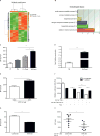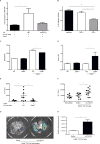Tumor-induced CD11b(+) Gr-1(+) myeloid-derived suppressor cells exacerbate immune-mediated hepatitis in mice in a CD40-dependent manner
- PMID: 25616156
- PMCID: PMC4425346
- DOI: 10.1002/eji.201445093
Tumor-induced CD11b(+) Gr-1(+) myeloid-derived suppressor cells exacerbate immune-mediated hepatitis in mice in a CD40-dependent manner
Abstract
Immunosuppressive CD11b(+) Gr-1(+) myeloid-derived suppressor cells (MDSCs) accumulate in the livers of tumor-bearing (TB) mice. We studied hepatic MDSCs in two murine models of immune-mediated hepatitis. Unexpectedly, treatment of TB mice with Concanavalin A (Con A) or α-galactosylceramide resulted in increased alanine aminotransferase (ALT) and aspartate aminotransferase (AST) serum levels in comparison to tumor-free mice. Adoptive transfer of hepatic MDSCs into naïve mice exacerbated Con A induced liver damage. Hepatic CD11b(+) Gr-1(+) cells revealed a polarized proinflammatory gene signature after Con A treatment. An IFN-γ-dependent upregulation of CD40 on hepatic CD11b(+) Gr-1(+) cells along with an upregulation of CD80, CD86, and CD1d after Con A treatment was observed. Con A treatment resulted in a loss of suppressor function by tumor-induced CD11b(+) Gr-1(+) MDSCs as well as enhanced reactive oxygen species (ROS)-mediated hepatotoxicity. CD40 knockdown in hepatic MDSCs led to increased arginase activity upon Con A treatment and lower ALT/AST serum levels. Finally, blockade of arginase activity in Cd40(-/-) tumor-induced myeloid cells resulted in exacerbation of hepatitis and increased ROS production in vivo. Our findings indicate that in a setting of acute hepatitis, tumor-induced hepatic MDSCs act as proinflammatory immune effector cells capable of killing hepatocytes in a CD40-dependent manner.
Keywords: CD40; Concanavalin A; Immune-mediated hepatitis; Myeloid-derived suppressor cells; Reactive oxygen species; α-Galactosylceramide.
Published 2015. This article is a U.S. Government work and is in the public domain in the USA.
Figures




Similar articles
-
Systemic Agonistic Anti-CD40 Treatment of Tumor-Bearing Mice Modulates Hepatic Myeloid-Suppressive Cells and Causes Immune-Mediated Liver Damage.Cancer Immunol Res. 2015 May;3(5):557-66. doi: 10.1158/2326-6066.CIR-14-0182. Epub 2015 Jan 30. Cancer Immunol Res. 2015. PMID: 25637366 Free PMC article.
-
Role of myeloid-derived suppressor cells in amelioration of experimental autoimmune hepatitis following activation of TRPV1 receptors by cannabidiol.PLoS One. 2011 Apr 1;6(4):e18281. doi: 10.1371/journal.pone.0018281. PLoS One. 2011. PMID: 21483776 Free PMC article.
-
The protective role of myeloid-derived suppressor cells in concanavalin A-induced hepatic injury.Protein Cell. 2014 Sep;5(9):714-24. doi: 10.1007/s13238-014-0069-5. Epub 2014 Jul 1. Protein Cell. 2014. PMID: 24981055 Free PMC article.
-
Myeloid-Derived Suppressor Cells in Trypanosoma cruzi Infection.Front Cell Infect Microbiol. 2021 Aug 27;11:737364. doi: 10.3389/fcimb.2021.737364. eCollection 2021. Front Cell Infect Microbiol. 2021. PMID: 34513737 Free PMC article. Review.
-
Hepatic myeloid-derived suppressor cells in cancer.Cancer Immunol Immunother. 2015 Aug;64(8):931-40. doi: 10.1007/s00262-015-1736-y. Epub 2015 Jul 2. Cancer Immunol Immunother. 2015. PMID: 26133122 Free PMC article. Review.
Cited by
-
Critical Role of Myeloid-Derived Suppressor Cells in Tumor-Induced Liver Immune Suppression through Inhibition of NKT Cell Function.Front Immunol. 2017 Feb 13;8:129. doi: 10.3389/fimmu.2017.00129. eCollection 2017. Front Immunol. 2017. PMID: 28243237 Free PMC article.
-
IL-1R1 Blockade Boosts CD40 Agonist Immune Responses but Fails to Improve Efficacy or Reduce Hepatotoxicity in Pancreatic Cancer.bioRxiv [Preprint]. 2025 Mar 17:2025.02.23.639774. doi: 10.1101/2025.02.23.639774. bioRxiv. 2025. PMID: 40060615 Free PMC article. Preprint.
-
Targeting the crosstalk between cytokine-induced killer cells and myeloid-derived suppressor cells in hepatocellular carcinoma.J Hepatol. 2019 Mar;70(3):449-457. doi: 10.1016/j.jhep.2018.10.040. Epub 2018 Nov 9. J Hepatol. 2019. PMID: 30414862 Free PMC article.
-
Hepatoprotective effect of capsaicin against concanavalin A-induced hepatic injury via inhibiting oxidative stress and inflammation.Am J Transl Res. 2019 May 15;11(5):3029-3038. eCollection 2019. Am J Transl Res. 2019. PMID: 31217872 Free PMC article.
-
Combining all-trans retinoid acid treatment targeting myeloid-derived suppressive cells with cryo-thermal therapy enhances antitumor immunity in breast cancer.Front Immunol. 2022 Nov 1;13:1016776. doi: 10.3389/fimmu.2022.1016776. eCollection 2022. Front Immunol. 2022. PMID: 36389684 Free PMC article.
References
Publication types
MeSH terms
Substances
Grants and funding
LinkOut - more resources
Full Text Sources
Other Literature Sources
Medical
Molecular Biology Databases
Research Materials

